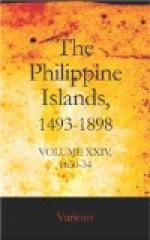how their divatas had told them true; for what could
be of greater use to them at that time than the rain,
so that the arms of the Castilians would be useless.
Consequently, they became like mad dogs; and they
preferred death to enduring the conditions of the
conqueror. But so many fell that death had to
fulfil its duty, namely, to inspire them with fear.
They wounded Don Juan with a stone, but not very dangerously,
as his morion received the blow. Although he fell,
he arose cured, and with renewed courage, by calling
on the Holy Child, who gave the Spaniards the victory,
and, with it, the islands for a second time.
Truly, had so good an outcome not befallen the Spaniards
in Bohol, there would not have been a single one of
the Pintados—and these form the bulk of
the islands—which would not have risen against
them. After this victory, those who had desired
to raise the yoke placed their necks once more under
it. However, it was not sufficient to deter the
natives of Leyte from likewise trying their fortune,
which resulted as ill to them as to the natives of
Bohol. Then the islands became quiet, and the
Indians more humble. However, whenever they see
their chance, they will not lose it, as they are a
people who wish to live free. The captured Indians
were made slaves for the space of ten years.
Upon learning of this affair, the governor approved
the enterprise, praised it, and promised to reward
it. This victory was recognized as the doing
of the most Holy Child. Consequently, Don Juan
de Alcarazo gave Him thanks, and shared the booty with
Him.
There was a terrible earthquake in the islands at
this time, which none of them escaped. In the
island of Panay, where I was stationed then, it lasted
more than a fortnight. But none of the succeeding
shocks were equal in violence to the first, which was
so severe that all expected everything to be overthrown.
The columns of the church and house, colliding against
one another, strewed the ground on all sides, so that
a thick club could easily be thrust around the columns.
The same thing happened in the other convents, where
the images fell and were broken into bits. In
the church of Passi, which is of stone, and was then
just roofed, all the upper part fell, and it sank
in many places. Many rivers changed their course,
as that of Aclan, which abandoned its former bed.
Mountains were opened, and there were innumerable
other terrible occurrences during that awful earthquake.
At last it was the Lord’s will that it should
cease, and with it the fears of all. In Ilocos
the shocks were also exceeding great, but not so severe
in Manila. The Lord allows all this, so that
we may recognize His power; and, recognizing it, love
Him; and, loving Him, not offend Him.




